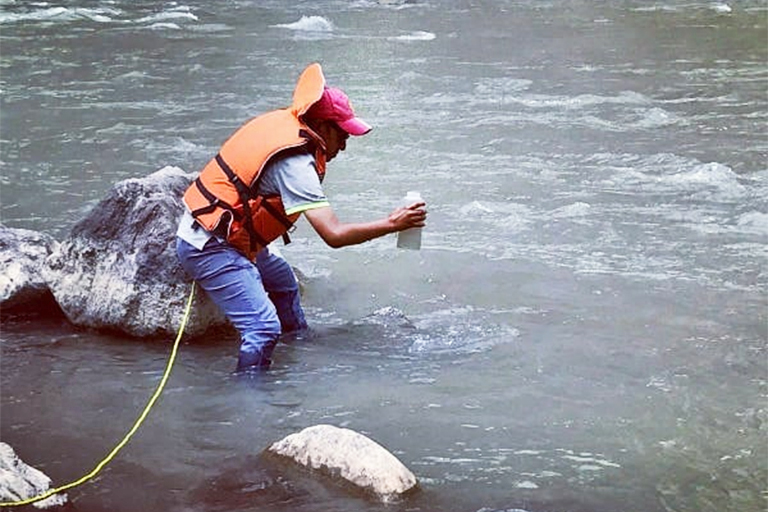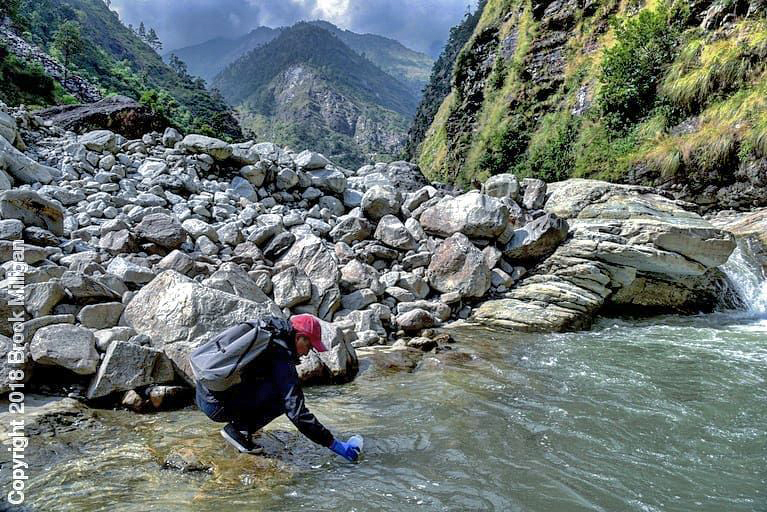- Conservation geneticist Adarsh Man Sherchan is one of the leading experts keeping track of the impacts that Nepal’s dozens of dams are having on freshwater species.
- The Himalayan country has more than 120 hydroelectricity plants, many of which were built without prior aquatic biodiversity assessments.
- With advances in assessment technologies, notably environmental DNA (eDNA), and a growing cohort of trained experts like Sherchan, there’s a greater focus on identifying and mitigating the impacts of dams on river life.
- In an interview with Mongabay, Sherchan talks about why eDNA is a gamechanger for monitoring species, the process of getting eDNA samples from rivers, and why jeans and flip-flops are a no-go for fieldwork.
KATHMANDU — With the start of the monsoon season in Nepal in mid-June, rivers originating from the mountains and the hills of the country become swollen and reach the peak of their flow. This is also the time when the country’s more than 120 hydropower plants start generating power up to their maximum capacity, allowing Nepal, a country once gripped by an acute power shortage, to even export electricity to neighboring India.
But the capture and release of water for electricity generation impacts aquatic life such as fish and macroinvertebrates. And until recently, Nepal didn’t have the capacity and the technology to assess the aquatic biodiversity in a river before hydropower plants were planned and built.
This is slowly changing with the availability of environmental DNA, or eDNA, and a growing cohort of experts trained to carry out aquatic biodiversity assessments in the country. One of them is conservation geneticist Adarsh Man Sherchan, who for more than a decade has worked on biodiversity assessments in both terrestrial and aquatic ecosystems.

Mongabay’s Abhaya Raj Joshi spoke with him recently about the challenges of using eDNA for aquatic biodiversity assessments in Nepal. The following interview was conducted in Nepali and has been translated and edited for clarity.
Mongabay: Could you please briefly tell us about yourself and how you got into conservation genetics?
Adarsh Man Sherchan: After graduating from the Royal Melbourne Institute of Technology [in Australia] in 2011 with a degree in molecular biology, I was working with my professor in plant-breeding programs when I decided to come back to Nepal. In 2013, when I was back home, the work by the Center for Molecular Dynamics Nepal, a research-driven NGO in Kathmandu, caught my attention. They were primarily doing a lot of non-invasive genetics work using DNA extracted from scat samples from wildlife such as tigers, leopards, elephants and even deer and bears.
The work provided extra layers of answers in terms of the animals’ population interactions, diet and subpopulations. This hadn’t been possible with the traditional morphological studies based on direct observations and camera traps.
Mongabay: Now let’s talk about eDNA and aquatic biodiversity assessments.
Adarsh Man Sherchan: The pioneering work on using eDNA to assess the biodiversity of a river system was carried out by CMDN and its team members, including me, between 2016 and 2018 as part of the Nepal fish biodiversity project, which was focused on the Karnali River system in western Nepal. Just as the project was wrapping up, USAID’s Paani program came along, and we also carried out biodiversity assessments of the Karnali River aligned with their specifications.
In 2019, around 25-30 national and international consultants working in the sector came together for a common cause under the Upper Trishuli 1 hydropower project. The objective was to create and design a manual that would standardize aquatic biodiversity assessments for hydropower projects using the different methods possible, including the use of eDNA. Results from both the assessments were recently published in a journal article.

Mongabay: How do you typically go about extracting eDNA from a river?
Adarsh Man Sherchan: On the face of it, eDNA is just taking scoops of water from the river and passing it through a filter with 0.4- to 0.5-nanometer pores, trapping as many cells as possible. However, where we get the scoops of water makes the difference. A river is not a uniform body of water, it has different features such as pools, pockets, boulders, tides.
Ideally, when we reach a site, we first look at the river from a vantage point to mark out its different characteristics. Ideally, we would look to take samples from stretches of the river with different characteristics.
We then take scoops of water and pass it through the filter using a vacuum … to speed things up. Once that’s done, we fold the filter aseptically and place it in a buffer liquid which ensures its quality even if we spend days in the field before heading to the lab. The liquid is literally like a vial of blood for us. When we are finally in the lab, we use the oldest trick in the book — centrifuge — to separate the cells from the buffer liquid.
Mongabay: Rivers originating from the Himalayas have been known to be very unpredictable in terms of their flow. Is that a challenge when collecting eDNA samples? Do you go to the river on rafts?
Adarsh Man Sherchan: The main principle we follow is that we should collect eDNA samples without disturbing the area’s natural state. No, we don’t use rafts. But we are clear that we are not going to take a risk beyond a certain point.
The main challenge in any fieldwork, including eDNA sampling, is safety. We ensure we are well roped and lifejacketed. Every time we go to the field, we write a separate risk assessment of around three to four pages and seriously convey it to the team members. This assessment includes small things such as proper clothes and footwear. In the past, we’ve had people show up in their jeans, which become really heavy when they get wet. There was another who came in flip-flops and sprained his ankle. When someone gets injured, the whole work gets behind schedule.

Mongabay: What are some of the risks you face?
Adarsh Man Sherchan: Water is the biggest risk. When you’re crossing a river less than knee deep, it looks easy from the outside. But when you’re in the middle of it, it doesn’t allow you to move. And that’s for shallow rivers. It gets exponentially tough with deeper water. There’s every possibility that you slip on the riverbeds, where there are large boulders in all directions.
When we collect eDNA from rivers, we usually take a team of around 10-12 people and we spend around 12-15 days in the field. We assign one person to just keep tabs on the water level in the river. Even if the water level rises by an inch, we abandon the mission and return to the banks.
As some of our team members collect eDNA samples, we have another set of members using fishnets to capture, measure and release live fish. This helps give tangible evidence to whatever results we may get from the eDNA samples.
Similarly, we need to closely observe the movement of the clouds as rains can increase the flow in the river and make the water turbid. That’s why we don’t sample when it’s raining.
In addition to this, we tell all hydropower stations upstream that we’re collecting eDNA samples from the river during certain days for certain hours, so that they don’t release water into the river. Such a release could easily sweep us away.

Mongabay: How about processing the eDNA samples?
Adarsh Man Sherchan: As I said earlier, the samples we collect in the buffer liquid are like vials of blood for us. Saving them is always a priority. When we’re back in the lab, we run them through a centrifuge and extract the cells that were stuck on the pores of the filter.
When we carry out the sequencing, that’s the trickiest part because these next-generation sequencers provide data on so many species that may have come in contact with the water. In other words, there’s a lot of noise in the data.
That’s where the experienced taxonomists, scientists with the knowledge of freshwater species and fish, play an important role. There are certain species that are only found in certain temperature ranges and certain seasons, and only a seasoned freshwater expert would know that. So we get their help to filter out the noise and then present our findings, either through a report to the people who commissioned the work, or as a research article in a journal.
Banner image: A river in Nepal. Image by Mario Micklisch via Flickr (CC BY 2.0).
Abhaya Raj Joshi is a staff writer for Nepal at Mongabay. Find him on Twitter @arj272.
Engineers bet on a miracle to bring Nepal’s holy river back to life
Citation:
Manandhar, P., Manandhar, S., Sherchan, A. M., Joshi, J., Chaudhary, H. K., Dhakal, B., … Karmacharya, D. (2023). Environmental DNA (eDNA) based fish biodiversity assessment of two Himalayan rivers of Nepal reveals diversity differences and highlights new species distribution records. PLOS Water, 2(6). doi:10.1371/journal.pwat.0000099
